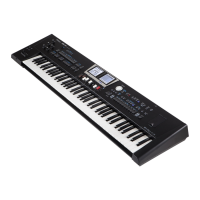‘Performance Edit’ parameters
129
The following parameters are available:
Parameter Setting Explanation
Switch O, On
This parameter allows you to switch the
equalizer on and o.
High Freq
1500 Hz, 2000 Hz,
3000 Hz, 4000 Hz,
6000 Hz, 8000 Hz,
12000 Hz
Allows you to set the cuto frequency of
the high band (this is a shelving lter).
High Gain –15~+15 dB
Use this parameter to set the level of the
selected “High” frequency.
Positive values boost (increase the
volume of) that frequency band,
negative values cut (attenuate) it.
Mid Freq 200~8000 Hz
Allows you to set the cuto frequency of
the middle band (this is a peaking lter).
Mid Gain –15~+15d B
Use this parameter to set the level of the
selected “Mid” frequency.
Mid Q 0.5, 1.0, 2.0, 4.0, 8.0
Use this parameter to specify the width
of the “Mid Frequency” band that you
want to boost or cut. Smaller values
mean that neighboring frequencies
above/below that value are also aected.
Low Freq
90 Hz, 150 Hz, 180
Hz, 300 Hz, 360 Hz,
600 Hz
Allows you to set the cuto frequency of
the low band (this is a shelving lter).
Low Gain –15~+15 dB
Use this parameter to set the level of the
selected “Low” frequency.
3. Press the [EXIT] button to leave the “Eq Part Edit” page.
Mfx
The BK-9 contains two multi-eects processor (“Mfx”) that can be
used to process the desired keyboard part(s). Select “O” for parts
that don’t need to be processed by this Mfx.
Parameter Setting
Mfx O, Mfx1, Mfx2
Expression Pedal
Select “O” if you don’t need pedal expression for the selected part.
This means that the keyboard part in question no longer responds
to an expression pedal you may have connected to the PEDAL
EXPRESSION jack.
Parameter Setting
Expression Pedal O, On
Exp Pedal Down and Exp Pedal Up
The expression pedal allows you to control the volume of all parts
by foot.
“Up” and “Down” refer to the volume that is used when the
expression pedal is pressed (“Up”, highest volume) or in the upright
position (“Down”, lowest volume).
You do not need to specify “0” for the “Down” position.
Selecting any other values will reduce the volume of the selected
part up to the “Down” value.
Likewise, you do not need to specify “127” as maximum value for
“Up”.
NOTE
The expression pedal sends MIDI Expression commands (CC11).
It is perfectly possible to set the “Down” value to “127” and the
“Up” value to “0”, so that the selected part only sounds when the
expression pedal is in the upright position. This can be used for
some clever eects: instead of alternating between the Upper1
and Upper2 parts by varying your velocity (which requires a
considerable amount of “striking precision”, see “Min Value” and
“Max Value” on p. 128), you could invert Uppert2 response
to the expression pedal, so that Upper1 doesn’t sound when
Upper2 does, and vice versa.
Parameters Setting
Pedal Exp Down
Pedal Exp Up
0~127
Hold Pedal
This parameter allows you to specify whether and how a hold
damper pedal you connect to the “PEDAL HOLD” jack should
respond to Hold messages (CC64).
Parameter Setting
Hold Pedal Auto, On, O
• “Auto” means that the part in question only responds to Hold
messages if it is assigned to the right half (Split) or the entire
keyboard.
• “On” means that the part in question always responds to Hold
messages, even if it is assigned to the left half of the keyboard.
• “O”, nally, means that the part does not respond to Hold
messages.
Octave Shift
Allows you to transpose the selected keyboard part in octave steps
Parameter Setting
Octave Shift –4~0~+4
Coarse Tune
Changes the pitch of the selected keyboard part in semi-tone steps.
Parameter Setting
Coarse Tune –24~0~+24
Fine Tune
Changes the pitch of the selected part in steps of 1 cent (1/100
semi-tone).
Parameter Setting
Fine Tune –100~0~+100
Portamento Mode
You can set the selected part to mono(phonic) mode.
Parameter Setting
Portamento Mode Patch, Poly, Mono
• “Patch” means that the setting depends on Tone’s Mono/Poly
setting.
• “Poly”, on the other hand, means that you can play chords using
the selected part
• “Mono” means that you can only play one note at a time. You
could select this mode to play a trumpet or woodwind part in a
more natural way.
Portamento Time
“Portamento” means that the pitch doesn’t change in clearly
dened steps: it produces glides from one note to the next. Use this
parameter to specify the speed at which those glides are carried
out. The higher is the value, the slower is the transitions.

